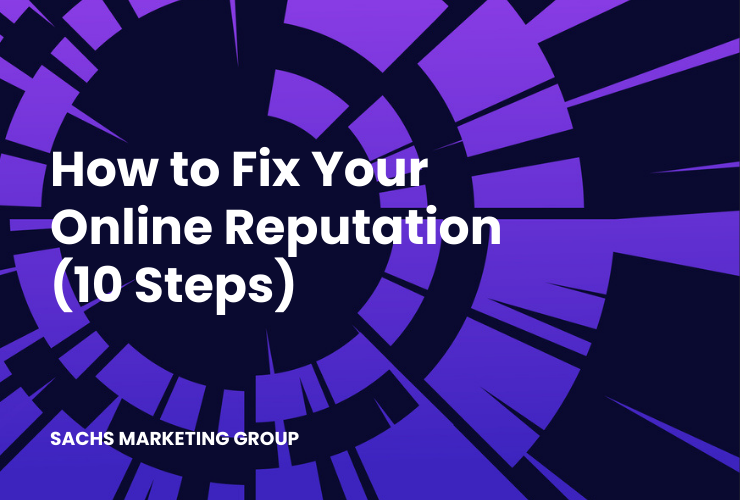Fixing your online reputation involves a strategic approach. Identify the cause of the negative reputation, rectify the issue, respond to reviews, collect positive reviews, and monitor your brand mentions. Regular content publication and search engine optimization are vital too.

You have worked hard to build your business, but a single negative review online is eroding your hard-earned reputation. What’s worse … that single negative review was from years ago.
Fortunately, by integrating a proactive approach to your online reputation management, you can fix your online reputation and prevent negative reviews from deterring future customers.
In this article, we’re exploring the impact of ignoring negative reviews and sharing 10 steps to help you understand how to fix your online reputation.
Overview
The Impact of Ignoring Negative Reviews
Ignoring negative reviews can have far-reaching implications for your business. Not only does it deteriorate your brand reputation, but it also sends a message that your business doesn’t value customer feedback.
This may deter potential customers who rely heavily on online reviews before making purchasing decisions. Furthermore, it may dissuade existing customers from continuing to patronize your business. Negative reviews, if left unaddressed, can also impact your business’s search engine rankings, making it harder for you to reach your target audience.
How to Fix Your Online Reputation
Fixing your online reputation begins with understanding the source of your negative reputation, making adjustments internally to avoid negative reviews in the future, actively building positive reviews, and creating a content marketing strategy that allows you to tell your brand’s story through social media posts and articles from your blog.
To help you get started, we’re breaking down this process into ten steps.
Step 1. Identify the Cause of Your Negative Reputation
Understanding the cause of your negative reputation is the first step toward resolving it.
Scrutinize online reviews, social media mentions, and any other feedback available on digital platforms.
- Are customers unsatisfied with your product or service?
- Did a one-time incident trigger a wave of negativity?
- Or are false accusations tainting your reputation?
These answers will guide your reputation management strategy.
A 2018 report from ReviewTrackers showed that 94% of customers report that a negative review has convinced them to avoid a business, emphasizing the importance of identifying the cause of negative sentiment.
Step 2. Solve the Problem and Learn from Mistakes
After identifying the cause, take immediate action to resolve the issue.
This could be as simple as issuing a public apology for a misunderstanding or as complex as overhauling your customer service protocol. Whatever the problem, be transparent about your commitment to making things right.
As Bill Gates famously said, “Your most unhappy customers are your greatest source of learning.”
Step 3. Respond to Reviews Carefully
Addressing negative reviews is an art. It requires diplomacy, professionalism, and a touch of humility.
Always thank the reviewer for their feedback, apologize if necessary, and offer a solution if possible. Avoid getting defensive. Your response will not only affect the original reviewer, but it will also be visible to potential customers.
Try responding to reviews using different templates to discover which responses work best. Once you’ve discovered how to respond to negative reviews for your business, you can create a template to save time.
Here’s an example of a templated response to a negative review.
A study by Harvard Business Review found that when businesses respond to customer reviews, they encourage more reviews and often see higher ratings.
Step 4. Remove Negative Reviews
When a negative review is false, biased, or violates the policies of the review platform, you may have grounds to request its removal. Platforms like Google, Yelp, and Facebook have guidelines against reviews that are inappropriate, off-topic, or malicious.
To remove such reviews, flag them for the platform’s support team and provide a detailed explanation of why the review violates their policies. However, be aware that the process can be time-consuming and there’s no guarantee the platform will agree with your assessment. In fact, according to a BrightLocal survey, only 25% of businesses have successfully had a negative review removed.
To successfully remove negative reviews, you must be careful how you flag reviews to ensure you’re following each platform’s policies. If you don’t, the platform will likely reject your suggestion to remove the negative review. This can be frustrating to busy business owners, which is why they often turn to a full-service digital marketing agency that offers reputation management services.
Step 5. Collect More Positive Reviews
Cultivating positive reviews can balance out negative ones, improving your overall online reputation. Implement a proactive approach to ask for reviews from satisfied customers.
For instance, you might send follow-up emails requesting reviews or create a section on your website where customers can easily share their experiences. Some businesses offer incentives for reviews, though be sure to maintain ethical guidelines. Review platforms like Yelp discourage incentivizing reviews as it can lead to biased feedback.
Always remember, authenticity is crucial in reviews as it builds trust and credibility with potential customers.
Step 6. Monitor Mentions of Your Brand Online
Monitoring your brand online enables you to capture a real-time picture of public sentiment toward your business. You can use free tools like Google Alerts or invest in specialized software like Mention or SproutSocial to track brand mentions across various online platforms.
Regularly check your social media notifications and messages, blog comments, forum threads, and anywhere else your brand might be discussed. By monitoring, you can promptly respond to negative feedback and nip potential issues in the bud before they escalate, as well as engage with positive mentions to strengthen your brand reputation.
Step 7. Create Social Media Profiles and Post Regularly
Consistent activity on social media not only improves your online visibility but also allows you to control the narrative around your brand. Regularly sharing content that reflects your brand values, mission, and achievements can shape public perception.
Social media also enables direct communication with your audience, allowing you to address issues promptly and personally. Importantly, regularly monitor and respond to comments, messages, and reviews on your social profiles.
A Sprout Social survey found that 40% of consumers expect brands to respond within the first hour of reaching out on social media, while 79% expect a response in the first 24 hours.
Create a social media content calendar and be sure to post and respond regularly.
Step 8. Create a Blog and Publish Articles Regularly
Regularly publishing high-quality, useful content on your blog can strengthen your reputation as an industry expert and reliable source of information.
Cover topics that are relevant to your audience and reflect your brand’s expertise. By doing this, you add value to your audience, foster trust, and create opportunities for your content to be shared across other platforms, enhancing your brand’s reach and reputation. In fact, HubSpot’s State of Inbound report found that marketers who prioritize blogging are 13x more likely to have a positive ROI.
Step 9. Use SEO to Boost the Positive / Bury the Negative
SEO is a potent tool for online reputation management. SEO strategies can be used to promote positive content about your business in search engine rankings, making it more visible to your audience.
Conversely, SEO can also help to “bury” negative content by pushing it down the search engine result pages. It’s worth noting that 75% of users never scroll past the first page of search results, so pushing negative content onto the second page or beyond can significantly reduce its visibility.
Step 10. Hire a Reputation Management Specialist
As businesses grow, so does the challenge of managing an online reputation.
Hiring a specialist or an agency with expertise in reputation management can provide significant benefits. Specialists can monitor your online reputation across platforms, develop strategies to cultivate positive reviews, manage responses to negative reviews, and use SEO to control the visibility of content.
Investing in reputation management services can offer peace of mind and allow you to focus on running your business, knowing that your online reputation is in expert hands.
Fixing Your Online Reputation FAQs
We help a lot of companies with their online reputation management, so we hear a lot of the same questions. Here are some of the most frequently asked questions along with our answers.
How long does it take to repair an online reputation?
Repairing an online reputation varies greatly depending on the extent of the damage and the strategies employed. For minor issues, it may take a few weeks or months. However, significant damage could require years to fully repair. Consistent effort and patience are essential.
How much does it cost to clean up your online reputation?
The cost of online reputation repair can vary significantly based on the severity of the damage and the methods used. Hiring a reputation management firm can range from $1,000 to $10,000 a month, but DIY solutions can be more affordable or even free, though more time-consuming.
How do I clean up my reputation on Google?
Cleaning up your reputation on Google involves multiple steps: addressing negative reviews, creating positive content, improving your website’s SEO, and actively managing your social media presence. Consistent monitoring and quick responses to online mentions of your brand can also help manage your reputation.
Can I remove bad reviews?
Yes, you can request the removal of bad reviews if they violate the platform’s policies. However, this isn’t always successful, and some platforms don’t allow it. Alternatively, responding professionally to negative reviews and taking steps to rectify the issue can often neutralize their impact.
Need Help with Your Reputation Management?
Maintaining a pristine online reputation can be challenging, especially when negative reviews or comments start to pile up. Sachs Marketing Group can help!
Our skilled digital marketing team uses proven strategies to restore and enhance your reputation. With years of experience handling negative reviews, generating positive reviews, and implementing processes designed to build a strong online reputation online over time, you can rest assured you’re in good hands when you partner with us.
Contact our team to learn how we can help your online reputation today.
Conclusion
Fixing your online reputation is not a one-time task, but an ongoing strategy. It requires constant monitoring, quick action, and, most importantly, a commitment to delivering high-quality products or services.
Remember, your online reputation is a digital reflection of your brand’s integrity, make it count!
Contact us today to get the conversation started!












